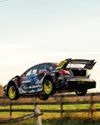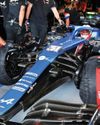
On 6 December 1979, Porsche’s director of public relations and sports, Manfred Jantke, invited the German media to the Intercontinental Hotel in Stuttgart to announce the plan to compete in the 1980 edition of the Indy 500.
For the German manufacturer’s first foray into American single-seater racing, long-time customer, Ted Field, and his Interscope Racing team was chosen as partner. Porsche would supply the engine and gearbox, while Interscope Racing would design and build a chassis for it.
A few days later, Jantke spread the same message to the American press at an event in New York. However, come May 1980, there was no sign of the promised Interscope Porsche Indy car. It did exist, but it had fallen victim to a combination of Porsche being Porsche and Indy being Indy.
One of the few motorsport arenas in which Porsche had not achieved success, the German manufacturer sent a delegation to the 1977 edition of the Indy 500. It was already decided that Porsche would enter American single-seater racing, but only as an engine supplier to an existing team.
Back burner
During the previous couple of years, Porsche’s Can-Am partner, Penske, had sent regular briefings to Weissach, in particular on the performance of the then dominant Off enhauser four-cylinder engine. But, for a variety of reasons, the dream partnership with Penske at Indy did not materialise, and the project was temporarily placed on the back burner.
This story is from the November 2020 edition of Racecar Engineering.
Start your 7-day Magzter GOLD free trial to access thousands of curated premium stories, and 8,500+ magazines and newspapers.
Already a subscriber ? Sign In
This story is from the November 2020 edition of Racecar Engineering.
Start your 7-day Magzter GOLD free trial to access thousands of curated premium stories, and 8,500+ magazines and newspapers.
Already a subscriber? Sign In
Talk the torque
More thoughts on in-wheel motors and their effects on twisting force
Rolling about
An explanation of the limitations of a previous load transfer article, bringing jacking forces into the mix
F1 breaks schedule records
The FIA has confirmed no fewer than 23 races on the 2022 Formula 1 World Championship schedule, the highest number of grands prix ever to be held in a single season, and that has led to criticism from some teams that will be on the road for eight months.

Under pressure
Toyota may have finished first and second at Le Mans this year, but the effort required to overcome a fuel delivery problem and finish with both cars was Herculean
Physics at work
Dutch company, Intrax, offers Racecar Engineering an insight into the technologies it employs to optimise its suspension products
Williams' 2030 ambition
Williams Racing has committed to becoming climate positive by 2030 as part of an all-new sustainability strategy.
Diff'rent strokes
Racecar looks at the different types of mechanical differential, their benefits and limitations
Das Boot
A curious Twitter exchange fired up a unique, hydrogen-powered, cross-country project that will contest the Baja 1000 in November 2022

Air born
Every racecar engineer's dream is a blank sheet of paper design. When Hoonigan and Subaru approached Vermont Sportscars about building the next generation of Gymkhana racer, that's just what the company was given

Remote control
Called variously ‘virtual garages’, ‘mission control’ or ‘race support rooms’ is the future of race engineering sitting in the warm back at HQ?